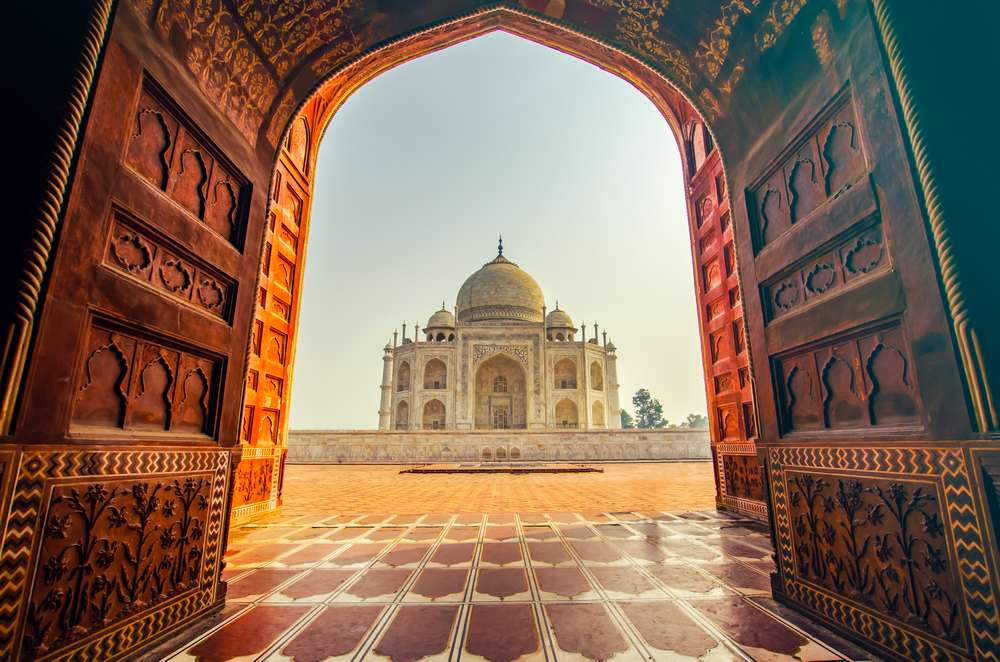India is a treasure store of history and culture, a nation with great variety. Architectural wonders, historic ruins, and massive monuments covering stories of empires, conquests, and cultural development abound in its terrain. For those who enjoy history, these magnificent sites serve as doors to a bygone period rather than as locations. These are some of India’s most stunning historical sites that should go on your bucket list.
The Timeless Taj Mahal
Without the Taj Mahal, no catalogue of India’s historical gems would be complete. Built by Emperor Shah Jahan in honour of his beloved wife Mumtaz Mahal, this white marble mausoleum in Agra represents unceasing love—a masterwork of Mughal architecture, with its complex carvings, symmetrical gardens, and Yamuna River reflection make-over.
Visiting the Taj Mahal beneath a full moon or at daybreak exposes its ethereal beauty since the marble changes colour with the light. It is an emotive experience that enthrals guests, not only a monument.
INDIAN VISA FOR MAURITIAN CITIZENS
Jaipur’s Amber Fort: A Blend of Grandeur and Elegance
Rising on the craggy hills of Rajasthan, Amber Fort is a magnificent fusion of Mughal and Hindu buildings. Built of yellow and pink sandstone, its striking façade contrasts with the complex latticework, mirrored ceilings, and exquisite frescoes.
One can practically hear royal footsteps as one walks across the Sheesh Mahal (Mirror Palace) and enjoys the Kesar Kyari gardens. History aficionados should visit the fort because of its architectural genius and strategic position.
Khajuraho Temples: A Celebration of Art and Spirituality
Renowned for their complex carvings and sculptures honouring love, life, and deity, Khajuraho temples in Madhya Pradesh were Designed by the Chandela dynasty between the ninth and twelve centuries. These UNESCO World Heritage Sites are a harmonic fusion of spirituality and art.
The superb carving detail in Khajuraho, which shows gods, heavenly entities, and human emotions with unmatched skill, distinguishes it. These temples are monuments to India’s rich creative and cultural legacy as much as architectural marvels.
Hampi: The Ruins of a Glorious Empire
Hampi is tucked beside the Tungabhadra River in Karnataka, an otherworldly scene of castles, temples, and ancient ruins. Originally the capital of the Vijayanagara Empire, this UNESCO World Heritage Site is a striking reminder of the grandeur of one of India’s most potent dynasties.
From the famous stone chariot at the Vittala Temple to the finely carved Virupaksha Temple, Hampi’s ruins transport guests to a time of wealth and creative brilliance. The boulder-strewn ground and sunset views from Matanga Hill enhance its magical appeal.
Fatehpur Sikri: The Ghost City
Built by Emperor Akbar close to Agra, Fatehpur Sikri is a superb illustration of Mughal urban design and architecture. Though it was the Mughal capital briefly, its splendour never lessens.
Panch Mahal, Jama Masjid, and the Buland Darwaza (Gate of Magnificence) are among its architectural jewels. The Mughal era’s artistic vision is reflected in the city’s red sandstone buildings and finely detailed carvings. Wandering this “ghost city,” one may almost hear whispers of its active past.
Ajanta and Ellora Caves: Monuments of Faith and Art
The rock-cut caverns of Ajanta and Ellora in Maharashtra are a UNESCO World Heritage Site, a reminder of India’s religious and creative past. The Ellora Caves have Hindu, Buddhist, and Jain temples, while the Ajanta Caves highlight complex Buddhist frescoes and sculptures.
Designed from one rock, the technical wonder known as the Kailasa Temple in Ellora defies understanding. These caverns are a spiritual trip across time where art and dedication meet in fantastic harmony.
The Majestic Mehrangarh Fort
Among India’s most prominent and striking forts, Mehrangarh Fort towers above the blue city of Jodhpur in Rajasthan. Its excellent walls and elaborate palaces chronicle royal splendour, valour, and mystery.
Inside the fort, the majestic Moti Mahal (Pearl Palace) and the finely ornamented Phool Mahal (Flower Palace) highlight Rajputana’s creative genius. The fort museum boasts a great collection of relics, from royal palanquins to ancient weaponry.
INDIAN VISA FOR MONGOLIAN CITIZENS
Konark Sun Temple: A Symbol of Celestial Beauty
Odisha’s UNESCO World Heritage Site, the Konark Sun Temple, is an architectural tribute to the sun god. Designed like a huge chariot with finely carved wheels, this 13th-century temple is a Kalinga architectural masterwork.
It is a visual feast, as the finely detailed carvings capture events from daily life, mythology, and celestial bodies. The temple’s grandeur and spiritual aura enthral visitors even if it is only partly in ruins.
Why These Sites Belong on Your Bucket List
India’s historical sites are histories of its rich and varied past, not only relics. Every site presents a different window into past societies’ architectural, spiritual, and creative successes. Seeing these sites is about immersing yourself in the tales, emotions, and inventiveness of the past rather than only about sightseeing.
These historical treasures—the Taj Mahal’s romantic appeal, Khajuraho’s artistic genius, or Ajanta and Ellora’s spiritual depth offer a fantastic trip through India’s rich legacy. Including them on your bucket list guarantees you will encounter the soul of a country whose inspiration has been felt for millennia.
More Articles: Why Saudi Arabia’s Heritage Sites Are UNESCO World Gems



